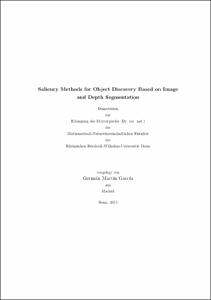Martín García, Germán: Saliency Methods for Object Discovery Based on Image and Depth Segmentation. - Bonn, 2016. - Dissertation, Rheinische Friedrich-Wilhelms-Universität Bonn.
Online-Ausgabe in bonndoc: https://nbn-resolving.org/urn:nbn:de:hbz:5n-44269
Online-Ausgabe in bonndoc: https://nbn-resolving.org/urn:nbn:de:hbz:5n-44269
@phdthesis{handle:20.500.11811/6850,
urn: https://nbn-resolving.org/urn:nbn:de:hbz:5n-44269,
author = {{Germán Martín García}},
title = {Saliency Methods for Object Discovery Based on Image and Depth Segmentation},
school = {Rheinische Friedrich-Wilhelms-Universität Bonn},
year = 2016,
month = jul,
note = {Object discovery is a recent paradigm in computer and robotic vision where the process of interpreting an image starts by proposing a set of candidate regions that potentially correspond to objects; these candidates can be validated later on by object recognition modules or by robot interaction. In this thesis, we propose a novel method for object discovery that works on single RGB-D images and aims at achieving higher recall than current state-of-the-art methods with fewer candidates. Our approach uses saliency as a cue to roughly estimate the location and extent of the objects, and segmentation processes in order to identify the candidates' precise boundaries. We investigate the performance of four different segmentation methods based on colour, depth, an early and a late fusion of colour and depth, and conclude that the late fusion is the most successful. The object candidates are sorted according to a novel ranking strategy based on a combination of features such as 3D convexity and saliency.
We evaluate our method and compare it to other state-of-the-art approaches in object discovery on challenging real world sequences from three different public datasets containing a high degree of clutter. The results show that our approach consistently outperforms the other methods. In the second part of this thesis, we turn to streams of images.
Here, our goal is to generate as few object candidates per frame as necessary in order to find as many objects as possible throughout the sequence. Therefore, we propose to extend our object discovery system with a so called spatial inhibition of return mechanism to inhibit object candidates that correspond to objects that have already been generated in the past. The challenge here is to inhibit the candidates consistently with viewpoint change, and therefore, we root our inhibition of return mechanism in 3D spatial coordinates. In the final part of this thesis we show an application of our object discovery method to the task of salient object segmentation. The results show that our method achieves state-of-the-art performance.},
url = {https://hdl.handle.net/20.500.11811/6850}
}
urn: https://nbn-resolving.org/urn:nbn:de:hbz:5n-44269,
author = {{Germán Martín García}},
title = {Saliency Methods for Object Discovery Based on Image and Depth Segmentation},
school = {Rheinische Friedrich-Wilhelms-Universität Bonn},
year = 2016,
month = jul,
note = {Object discovery is a recent paradigm in computer and robotic vision where the process of interpreting an image starts by proposing a set of candidate regions that potentially correspond to objects; these candidates can be validated later on by object recognition modules or by robot interaction. In this thesis, we propose a novel method for object discovery that works on single RGB-D images and aims at achieving higher recall than current state-of-the-art methods with fewer candidates. Our approach uses saliency as a cue to roughly estimate the location and extent of the objects, and segmentation processes in order to identify the candidates' precise boundaries. We investigate the performance of four different segmentation methods based on colour, depth, an early and a late fusion of colour and depth, and conclude that the late fusion is the most successful. The object candidates are sorted according to a novel ranking strategy based on a combination of features such as 3D convexity and saliency.
We evaluate our method and compare it to other state-of-the-art approaches in object discovery on challenging real world sequences from three different public datasets containing a high degree of clutter. The results show that our approach consistently outperforms the other methods. In the second part of this thesis, we turn to streams of images.
Here, our goal is to generate as few object candidates per frame as necessary in order to find as many objects as possible throughout the sequence. Therefore, we propose to extend our object discovery system with a so called spatial inhibition of return mechanism to inhibit object candidates that correspond to objects that have already been generated in the past. The challenge here is to inhibit the candidates consistently with viewpoint change, and therefore, we root our inhibition of return mechanism in 3D spatial coordinates. In the final part of this thesis we show an application of our object discovery method to the task of salient object segmentation. The results show that our method achieves state-of-the-art performance.},
url = {https://hdl.handle.net/20.500.11811/6850}
}






